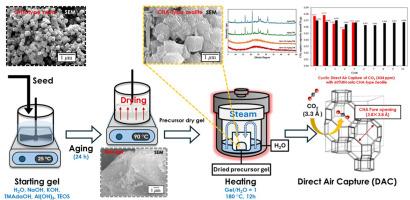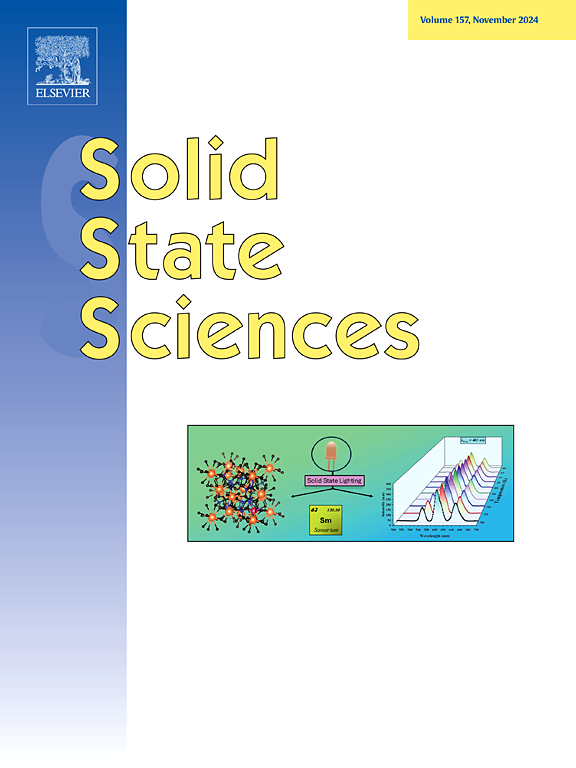通过干凝胶转化法优化cha型沸石合成以直接空气捕集CO2:种子添加量、水/凝胶比、结晶条件和老化时间的影响
IF 3.3
3区 化学
Q2 CHEMISTRY, INORGANIC & NUCLEAR
引用次数: 0
摘要
二氧化碳(CO2)是人类活动排放的最普遍的温室气体,对全球变暖起着重要作用。开发高效和更环保的二氧化碳捕获技术对于应对这一环境挑战至关重要。本研究采用环境友好型干凝胶转化(DGC)法合成了cha型沸石,重点对关键合成参数进行了优化。所得cha型沸石的比表面积为71 m2/g,孔体积为0.163 cm3/g。首次对DGC法合成的cha型沸石在空气直接捕集条件下(434 ppm CO2)、相对湿度60%下的CO2吸附性能进行了评价。经过10个吸附循环,由Si/Al = 75的凝胶组成合成的cha型沸石的CO2捕获能力在0.068±0.011 mmol-CO2/g-吸附剂范围内,与其他沸石相比,在潮湿条件下相对较高。循环吸附试验表明,该材料在重复捕获循环中保持其性能。这些结果突出了采用环境友好型DGC方法合成的cha型沸石在有效捕获低浓度CO2方面的潜力。本文章由计算机程序翻译,如有差异,请以英文原文为准。

Optimizing CHA-type zeolite synthesis via dry gel conversion method for direct air capture of CO2: Effects of seed addition, H2O/Gel ratios, crystallization conditions, and aging time
Carbon dioxide (CO2) is the most prevalent greenhouse gas emitted by human activities, contributing significantly to global warming. Developing efficient and more environmentally friendly CO2 capture technologies is crucial in addressing this environmental challenge. This study synthesized CHA-type zeolite using the environmental-friendly dry-gel conversion (DGC) method, with an emphasis on optimizing key synthesis parameters. The resulting CHA-type zeolite exhibited a surface area of 71 m2/g and a pore volume of 0.163 cm3/g. The CO2 adsorption performance of CHA-type zeolite synthesized via DGC method was evaluated for the first time under direct air capture conditions (434 ppm CO2) with 60 % relative humidity. Across ten adsorption cycles, the CHA-type zeolite synthesized from a gel composition of Si/Al = 75 demonstrated a CO2 capture capacity in the range of 0.068 ± 0.011 mmol-CO2/g-sorbent, which is relatively high compared to other zeolites under humid conditions. The cyclic adsorption tests indicate that the material maintains its performance over repeated capture cycles. These results highlight the potential of CHA-type zeolite, synthesized using the environmentally friendly DGC method, for efficiently capturing low concentrations of CO2.
求助全文
通过发布文献求助,成功后即可免费获取论文全文。
去求助
来源期刊

Solid State Sciences
化学-无机化学与核化学
CiteScore
6.60
自引率
2.90%
发文量
214
审稿时长
27 days
期刊介绍:
Solid State Sciences is the journal for researchers from the broad solid state chemistry and physics community. It publishes key articles on all aspects of solid state synthesis, structure-property relationships, theory and functionalities, in relation with experiments.
Key topics for stand-alone papers and special issues:
-Novel ways of synthesis, inorganic functional materials, including porous and glassy materials, hybrid organic-inorganic compounds and nanomaterials
-Physical properties, emphasizing but not limited to the electrical, magnetical and optical features
-Materials related to information technology and energy and environmental sciences.
The journal publishes feature articles from experts in the field upon invitation.
Solid State Sciences - your gateway to energy-related materials.
 求助内容:
求助内容: 应助结果提醒方式:
应助结果提醒方式:


